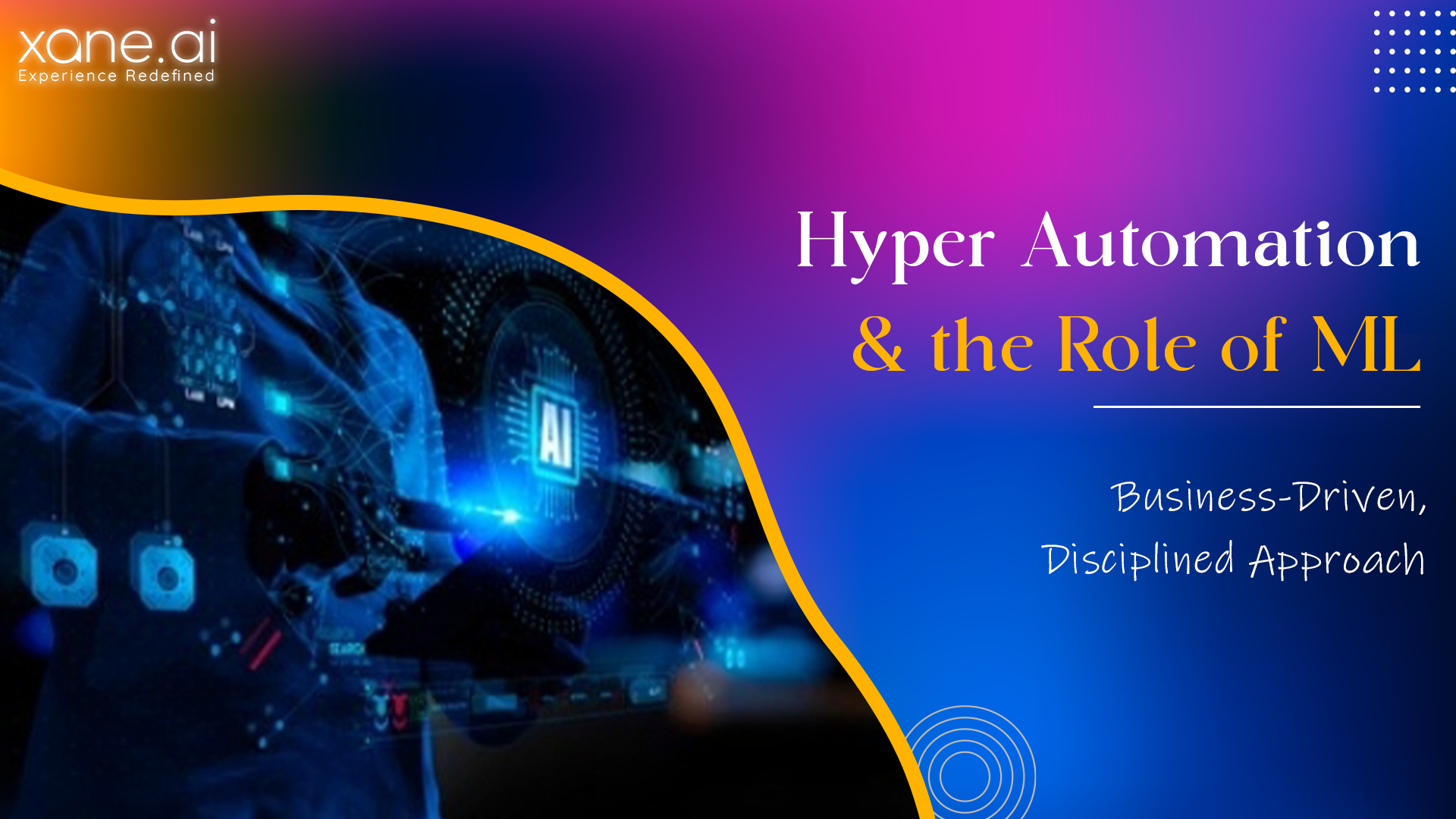
09 Mar Hyper Automation and the Role of Machine Learning
Blog by Oluwasegun Oke
The current trends aimed at making complex and repetitive business processes more suitable for all levels of enterprises, by developing a robust and higher quality automating system, capable of handling both business and IT processes, has been acknowledged, as beyond a landmark achievement, and is currently attracting more stakeholders, while continually generating equal facets of benefits for investors. In doing this, previous cumbersome and time-intensive repetitive processes and tasks, which often require highly specialized teams, can now be initiated and performed using a desirable automation system, powered by hyper-automation.
Hyperautomation
It refers to an advanced level automation technology, which combines Robotic Process Automation, Machine Learning (ML) Artificial Intelligence (AI), Optical Character Recognition (OCR), and Natural Language Processing (NLP) among others, to harness and seamlessly automate business and IT processes of different contextual architectures, orientations, features, and data complexities, utilizing digitalized high-speed routes, and packaged tools, within a virtual working environment.
This rare end-to-end integration of formerly compartmentalized business and IT processes has gained worldwide support, and adoption, across emerging fields, and even beyond traditional business territories.
In doing so, it enables business owners to expend less precious time on mundane or cumbersome operations, with improved security, reduced cost of labor budget, augmented governance, and above all, delegating expectant priority to other pressing needs, with deep creativity foundations and variability backgrounds.
Why More Businesses are Deploying Hyperautomation in Various Operations?
The business of automating expediently emerging processes was once a challenging crossroad, and financially intensive, due to adhering to squarely rules-based or script text logic and other technically rooted data-driven operations. They used to be tasks that were as well, time-consuming and often led to abandoned projects, that are not applicable to past simpler automation experience, and future prospects. Hyperautomation is therefore not only able to seamlessly automate considerably long chains of complex processes but also becoming a benchmark for any possible end-to-end permanent bonding for extensively unidentical processes under consideration.
These unique characteristics of Hyperautomation to remain relevant, by replacing previous error-prone manual approach, and being fundamentally efficient in automating nonselected value chains of business and IT processes, makes it a landmark AI breakthrough and the first choice in facilitating today’s data-driven business solutions.
Distinguishing Between RPA and Hyperautomation
RPA present a rule-based approach, incorporating bots and a firm data body network, to perform simpler actionable tasks (manual approach), whereas hyper-automation excels abundantly and supersedes RPA by utilizing more sophisticated data orientation, from a variety of sources, with highly effective processing that leverage Machine Learning (ML), Optical Character Recognition (OCR), Natural Language Processing (NLP), and Artificial Intelligence (AI).
With these powerful tools in place, businesses found a goldmine in big data, which was previously a permanent brick wall, and a huge challenge, since hyper-automation guarantees a more flexible, quicker, and highly dependable quality automation, no matter how varied, the margins of data orientation.
Toolchains for Hyperautomation
The digital space is fast becoming more invaded and inundated with fast-rising enterprises, looking to accelerate their digital infusion capacity, by as well fast-tracking the adoption of hyper-automation into every business endeavor, to fully and gainfully automate mundane business operations and tasks, across marketplaces. And here are the toolchains to achieving optimum hyper-automation implementation:
Process or Task Mining
Every potential business item for automation must be thoroughly and effectively sought out within hidden processes, and process variants, through their event logs, which must be thoroughly combed or discovered using task mining tools.
Task Capture
It allows for the identification of inherent RPA opportunities to develop the initial process for hyper-automation, by manually capturing the process and task through recorders, sitting on workers’ desktops.
Process Modelling
To encourage change management and automation governance, process modeling must be put in place, to integrate processes with inclusive expedient information, such as legacy systems and regulations, etcetera. It makes, therefore, a centralized storehouse, that contains all your as-is processes. In addition to this, it leverages a process editor, enabling your collaborators to design and optimize your to-be automated process.
RPA Platform
A platform that allows your developers to design, implement, and deploy bots.
Analytics and Reporting

It is useful and efficient in measuring ROI and having insightful information within your automated business processes, in terms of being prone to error, or pointing out unwanted flaws during operations, by offering metrics of most engaged process divisions.
RPA vs Hyperautomation
For instance, common automation takes place when a bot extracts specific components of customer information from invoices and registers them into a centralized database system. The extracted information, in this case, only contains a subset of data of the generally required steps to process completely every invoice. Using RPA in concluding each sub-processing only enables much quicker operations with high accuracy but has not entered every invoice information into the central database system. RPA is, therefore, the automation of much simpler and largely rules-based processes and tasks. Furthermore, we can conclude that RPA is just a small slice, out of hyper-automation pizza. Bluntly put, it meets solutions at the sub-unit level. And it reminds us that most automated processes out there, being installed by the majority of enterprises, are sub-units of much larger complete processes and tasks, in order to gradually achieve their multi-layered complete projects.
Hence only when RPA end-results of sub-processes are joined end-to-end can the complete project be executed successfully. On the other hand, hyper-automation takes care of this at once (no need of joining sub-processes).
General Importance of Hyperautomation
Since the advent of Hyperautomation, many interests, not to mention diverse and newly emerging digital channels for business opportunities have been unlocked. However, without the unique qualities and inherent attributes of hyper-automation, these would not have taken place. And here, we look at hyper-automation applications, including benefits and how they have impacted businesses:
- Improves the quality of derivable data-driven insight for tailor-made business marketing initiatives.
- It empowers stakeholders to extract desirable insights, in order to redeem prospects, and design better fitted actionable long-term programs, for any enterprise.
- Quicker and accurate centralized processing of unstructured and structured data.
- Actionable end-to-end actualities of previously unattainable automation of complex business processes of different contextual architectures and orientations.
- Training and producing more experienced and digitally informed operators, with cutting-edge tools, at their disposal.
- A complete circle of automation possibilities, without taking any risk of running into a hidden brick wall.
- Promotes higher rates of collaborating progression between workforce, by meeting their needs, under the framework of big data.
- Takes into account better customer expectations, while streamlining and enhancing supply chain initiatives.





